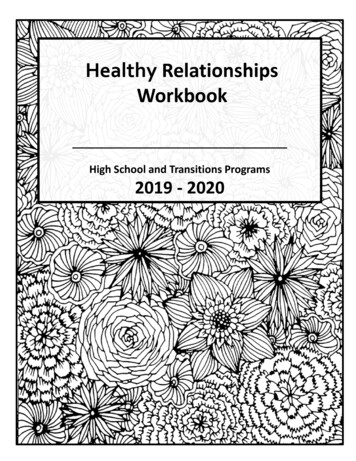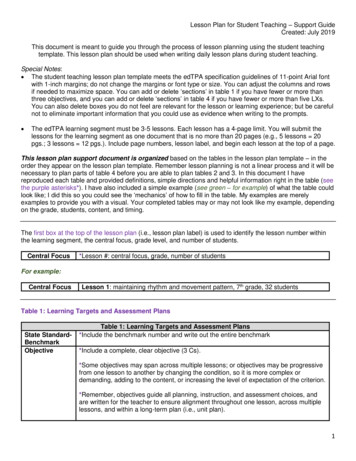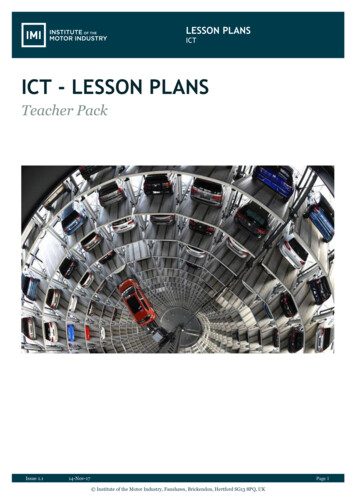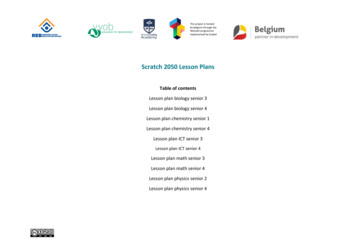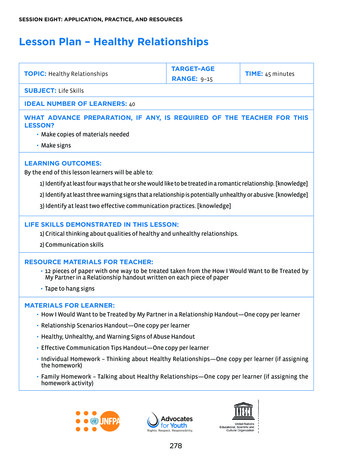
Transcription
SESSION EIGHT: APPLICATION, PRACTICE, AND RESOURCESLesson Plan – Healthy RelationshipsTOPIC: Healthy RelationshipsTARGET–AGERANGE: 9–15TIME: 45 minutesSUBJECT: Life SkillsIDEAL NUMBER OF LEARNERS: 40WHAT ADVANCE PREPARATION, IF ANY, IS REQUIRED OF THE TEACHER FOR THISLESSON? Make copies of materials needed Make signsLEARNING OUTCOMES:By the end of this lesson learners will be able to:1) Identify at least four ways that he or she would like to be treated in a romantic relationship. [knowledge]2) Identify at least three warning signs that a relationship is potentially unhealthy or abusive. [knowledge]3) Identify at least two effective communication practices. [knowledge]LIFE SKILLS DEMONSTRATED IN THIS LESSON:1) Critical thinking about qualities of healthy and unhealthy relationships.2) Communication skillsRESOURCE MATERIALS FOR TEACHER: 12 pieces of paper with one way to be treated taken from the How I Would Want to Be Treated byMy Partner in a Relationship handout written on each piece of paper Tape to hang signsMATERIALS FOR LEARNER: How I Would Want to be Treated by My Partner in a Relationship Handout—One copy per learner Relationship Scenarios Handout—One copy per learner Healthy, Unhealthy, and Warning Signs of Abuse Handout Effective Communication Tips Handout—One copy per learner Individual Homework – Thinking about Healthy Relationships—One copy per learner (if assigningthe homework) Family Homework – Talking about Healthy Relationships—One copy per learner (if assigning thehomework activity)278
SESSION EIGHT: APPLICATION, PRACTICE, AND RESOURCESLesson Plan – Healthy RelationshipsThis lesson is enhanced when learners have the following background knowledge: Content from theInternational Technical Guidance on Sexuality Education—Key Concept 1 – Relationships; 1.2 – Friendship,Love, and Romantic RelationshipsPROCEDURE:Step 1)Introduce the lesson by saying, “Today we are going to talk about relationships and how to have healthy andhappy relationships. We will discuss how someone might recognize if they are in an unhealthy relationshipand what kinds of communication skills can help us have the relationships we want.”Step 2) 5 minutes for Steps 1 & 2Distribute the handout “How I Would Want to be Treated by My Partner in a Relationship” to each learner.Explain to students, “This worksheet has a list of ways you perhaps would want to be treated by a romanticpartner, whether now or in the future. Looking at this list, think about which ones are most important toyou. Circle three that you think are most important Then, choose your top item, and write a brief explanationabout it on the bottom of your worksheet. Once you are finished, you will have a chance to share some ofyour thinking.” If a student asks if they can add any qualities to the list, you can let them know that they canadd a quality, but for the sake of this activity, they cannot choose it as their “#1 Quality.”Step 3) 15 minutesWhile students are working, hang the 12 previously made signs around the classroom. Once learners aredone instruct them to find the three qualities that they chose on their worksheet and put their initials oneach of those pieces of paper with that quality hanging around the room. Then, have students stand by thequality they rated at #1.Once the learners have initialed the three signs and are standing next to their #1 quality, debrief several of thetop–scoring items, including why people chose them and what that quality would look like in a relationship.Sample discussion questions (these assume that “respect” had been a popular choice among learners butit would be whatever leaners chose most) might include: Why did you all choose respect? Direct the question to the group standing by the sign. Did anyone else choose respect for a different reason? Directed to the rest of the class. How could someone show their romantic partner that they respect them? What are some disrespectful things a romantic partner might do?279
SESSION EIGHT: APPLICATION, PRACTICE, AND RESOURCESLesson Plan – Healthy RelationshipsPROCEDURE (CONTINUED):Step 4)Pass out the Healthy, Unhealthy, and Warning Signs of Abuse Handout.Tell learners, “It sounds like you all know how you would like to be treated in your relationships, which is soimportant. In fact, sometimes people don’t actually know what they want in a partner and that makes it hardto have a happy and healthy relationship. I am really glad to see that so many of you are already thinkingabout what would be important to you. I have just handed out a sheet that lists many of the qualities wehave just been discussing, as well as some qualities of an unhealthy relationship because while it’s importantto know what you would be looking for in a relationship, it’s also important to be able to recognize whena relationship is unhealthy. Let’s take a look at a couple of real–life scenarios. We can use the qualities onthis sheet to help us examine their relationships.”Step 5) 15 minutes for Steps 4 & 5Pass out the Relationship Scenarios Handout. Have a volunteer from the class read Scenario 1, Marcus andLillian, first. Debrief with questions listed below. Repeat with Scenario 2, Tasneem and Kato. Do you think this is a healthy or unhealthy relationship? Why? What characteristics from your handout do you see in their relationship? (If they simply list a qualityfrom the handout, prompt them to describe the specific behavior from the scenario that illustratesthat quality.)Marcus and Lillian debrief:The class should identify this scenario as having several qualities of an unhealthy or abusive relationship,including: Trying to limit or control what the other person does Is often jealous Throws or breaks things during a fightHowever, they may also see some qualities from the healthy relationship list, such as that Marcus stateshe trusts Lillian and that he loves her.It is important to emphasize that while Marcus may love and trust Lillian, his actions are unacceptableand make for an unhealthy relationship. If he can learn to control his anger, perhaps they could have ahealthy relationship. However, Lillian does not deserve to be treated in this way and it would be unsafefor her to stay in the relationship at this point.280
SESSION EIGHT: APPLICATION, PRACTICE, AND RESOURCESLesson Plan – Healthy RelationshipsPROCEDURE (CONTINUED):Tasneem and Kato debrief:The class should identify this scenario as having several qualities from the healthy relationship list, including: Being supported and encouraged Being treated as an equal Being honestTasneem and Kato have different interests, but still support one another in the things that are importantto them. Neither of them feels the need to give up their individual interest or feels forced to join theinterest of the other person. They are honest with each other and were able to negotiate a compromisethat they were both happy with.[Teacher’s Note: If you are able to explore same–sex relationships, it can be a great teaching opportunity tomake the names of the two characters in either scenario the same gender.] This can normalize relationshipsbetween gay, lesbian and bisexual people and reinforce that everyone, no matter their sexual orientation,deserves to be in a healthy relationship. If your leaners express the opinion that two people of the samegender being in a romantic relationship with each other is never a healthy choice, it’s important to point outthat, although people have differing beliefs about the rightness or wrongness of gay and lesbian relationships,any two people’s relationship can have healthy or unhealthy characteristics, such as those listed on thehandout. Some gay and lesbian relationships are healthy and some are not, just like some heterosexualrelationships are healthy and some are not. Redirect the conversation by explaining that the point of thelesson is to give learners tools to evaluate the health of their own relationships.Step 6) 10 minutesExplain to students, “I want to thank you for really taking the time to think about what would be importantto you in a relationship, and what might be some signs that a relationship is unhealthy. Now let’s think abouthow communication fits into a healthy relationship, as good communication is fundamental to a healthyrelationship.” Hand out Effective Communication Tips Handout to each learner and review together withthe group by asking any of the following questions: What do you think about the communication tips on this handout? Which ones do you already use? Which ones do you think are more difficult to use and why? Why do you think these tips lead to more effective communication?Close the lesson by saying, “Relationships are at the heart of being human and everyone deserves happyand healthy relationships. Hopefully some of the information we discussed today will help you have healthyrelationships in the future.”281
SESSION EIGHT: APPLICATION, PRACTICE, AND RESOURCESLesson Plan – Healthy RelationshipsKEY MESSAGES OF LESSON:1) Healthy relationships are very important and take work.2) It’s important to know the warning signs of unhealthy relationships and how to get help.3) Knowing the qualities you would like in a partner is important to being safe and healthy.4) Communication is a key part of a healthy relationship and practicing these skills can help you buildand keep a healthy relationship.ASSESSMENT OF LEARNING OBJECTIVES AT CONCLUSION OF LESSON: Teachers can collect the How I Would Want to be Treated by My Partner in a Relationship Handout forassessment of the learning objectives. Additionally, assigning either the individual or family homeworkactivity could be another way to assess learning.HOMEWORK WITH FOCUS ON FAMILY INVOLVEMENT ACTIVITIES: Use the Talking about Healthy Relationships worksheet and a clean copy of the How I Would Wantto be Treated by My Partner in a Relationship Handout. See each worksheet for detailed directions.POSSIBLE ADAPTATIONS:1) Large class size—None2) Limited materials/technology—NoneAdapted from: Family Life and Sexual Health – High School Lesson 5: Healthy Relationships Seattle-King County Department of Public Healthwww.kingcounty.gov/health/flash282
SESSION EIGHT: APPLICATION, PRACTICE, AND RESOURCESHow I Would Want to Be Treated by My Partnerin a Relationship HandoutDirections: Please review the following list and circle 3 ways you would want to be treated in arelationship that are most important to you. You may see many qualities here that you like, buttry to pick your top three. Follow the directions at the bottom of the page after you have pickedyour top three.I want my partner to Treat me with respectBe trustworthyNeed meTreat me fairlySupport meBe honest with meTreat me as an equalMake me laughEncourage meProtect meTrust meLove meLooking at the three you chose, please list the number one most important way you wouldlike to be treated by a romantic partner and write a brief explanation of why that quality isso important.#1 Quality:Explanation:283
SESSION EIGHT: APPLICATION, PRACTICE, AND RESOURCESRelationship Scenarios Handout1. Marcus and LillianMarcus really likes Lillian – she is pretty and smart. Marcus often feels nervous that he might loseher to another boy. He doesn’t think she would ever cheat on him, but he does see her talking withother boys sometimes. It makes him feel so jealous he doesn’t know what to do. He told her thatshe needed to stop talking with those other boys, especially right in front of him! Lillian got upsetwith him, and they had a huge fight. As they were arguing, Marcus felt so mad that he grabbedher by the arms to get her to listen to him and then threw his book bag across the room. Marcuspromised Lillian it would never happen again. He says it was an accident, and he didn’t mean tohurt anyone. He just couldn’t control himself when he was feeling so angry.2. Tasneem and KatoTasneem and Kato really like each other. Kato loves to play soccer and has hopes of joining a leaguesomeday. He has just started to play with a group after many hours of practice over the past fewmonths. He excitedly calls Tasneem to tell her about the first game that he will be playing in. Tasneemis not so sure that she can go but still talks and listens throughout the entire conversation, showingKato how excited she is for him. Tasneem knows how much the team means to Kato, and wantsto support him but Tasneem tells him that she can’t come because she has a meeting that night.Kato is disappointed, and wishes that Tasneem would just forget about her meeting and come tothe game anyway. But, he knows that the meeting is as important to Tasneem as soccer is to him.Kato tells Tasneem that it would really mean a lot to him if she came to the game, and Tasneemagrees to come to the second half, after her meeting is over. Kato is happy that she can come tothe 2nd half and understand that Tasneem also has an important commitment on that same day.284
SESSION EIGHT: APPLICATION, PRACTICE, AND RESOURCESHealthy, Unhealthy, and Warning Signsof Abuse HandoutIn a healthy relationship people Treat their partner with respect and fairness Support and encourage each other Treat each other as equals Are honest Earn their partner’s trust Have shared interests Also have separate interests and identities Try hard to have honest and clear communication Enjoy being with each other Never hurt their partner physically or sexuallyIn an unhealthy relationship people Treat their partner disrespectfully and unfairly Frequently argue or fight Have no shared interests Or they do things ONLY with each other – they have no separate friends or interests Cheat on their partner Don’t care about their partner’s feelings Don’t enjoy spending time togetherWarning signs of an abusive relationship include One person throws or breaks things during an argument One person tries to control what the other person does, who they see, what they wear, orwhat they say One person is often jealous or is overly jealous One person hurts the other person physically or sexually One person puts the other person down, calls them names or humiliates them “Crazy–Making” behavior—this is when one person lies or changes their story, or when theydeny or minimize the other person’s experience. This behavior often makes the other personfeel like they are “going crazy.”285
SESSION EIGHT: APPLICATION, PRACTICE, AND RESOURCESEffective Communication Tips HandoutVoiceMake sure the tone of your voice and the volume of your voice are right for what you are saying.IntentKnow what you want if you are asking for something. What outcomes would be okay with you?Body LanguageThink about what you are saying with your body. Are your arms folded? Are you looking somewhereelse? Are you turned towards the person or away from them? It is best when your body languageis saying the same thing your words are saying.TimingThink about when you are going to ask for something or bring up a difficult topic. Does the otherperson have the time and energy to devote at that moment?ApproachThink about how you bring something up. Are you defensive, attacking or angry? Or are you calmand open to hearing the other person’s thoughts?Being ClearKnow what it is you want to say or bring up. Pay attention to word choice, tone of voice, and bodylanguageEffective communication often includes: “I” statements (“I think ”, “I want ”) Expressing opinions (“I believe ”) Saying “No” firmly but respectfully Asking for what you want Initiating conversations Expressing positive feelings Expressing appreciation Stating your strengths and abilities (“I can ”)286
SESSION EIGHT: APPLICATION, PRACTICE, AND RESOURCESIndividual Homework – Thinking aboutHealthy Relationships1. List 3 things you might say or do if a friend told you that they were feeling scared oftheir partner.A)B)C)2. Briefly describe why you chose one of the three qualities from the How I Would Wantto be Treated by My Partner in a Relationship worksheet.3. Describe how you would use one of the Effective Communication Tips listed on yourworksheet to bring up a difficult topic with your parents.287
SESSION EIGHT: APPLICATION, PRACTICE, AND RESOURCESFamily Homework – Talking about HealthyRelationships (Optional)PURPOSE: This is a chance to ask someone in your family about relationships and to share beliefsrelated to sexuality and relationships with each other. It will also give you a chance to get to knowone another a little better.DIRECTIONS: Find a place where you and a trusted adult (parent, guardian, grandmother, aunt oruncle, or adult friend of the family, etc.)—can talk. Set aside about 10 minutes. You will be sharingsome questions with the trusted adult that you will both discuss together. During this time, pleasegive full attention to one another.Before starting the discussion, explain that: Both of you are each welcome to say, “That question is too private. Let’s skip it.” What you discuss will not be shared with anyone else, even within the family, unless you giveone another permission to share it. It’s okay to feel silly or awkward and it’s important to try to do the homework together anyway.SHARE AND EXPLAIN the handout “How I Would Want to be Treated by My Partner in a Relationship.”DISCUSS the following questions, by taking turns asking each other the questions. When it is yourturn to listen, really try to understand the other person’s response. Which qualities listed on the worksheet are most important to you in your relationships? Which qualities listed do you hope that I would have in a romantic relationship? Are there other qualities you think are important that are not listed here? What are they? What is one piece of advice you would give someone about how to have a happy and healthyrelationship?288
Directions: Please review the following list and circle 3 ways you would want to be treated in a relationship that are most important to you. You may see many qualities here that you like, but try to pick your top three. Follow the directions at the bottom of the page after you have picked your top three.

